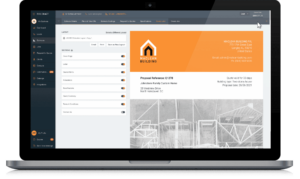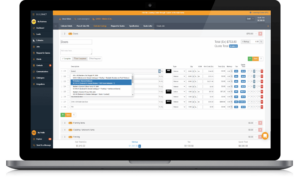Quality control represents an essential aspect of operating a successful home construction business. Home builders need to remember the many ways to ensure quality control, and construction job managers and their team need to be on top of this as part of their daily activities at the job site.
What is construction quality control?
Construction quality control must take place at every step, from preconstruction tasks to the final invoice. Construction quality control means that construction business leaders have quality control procedures in place to assure suppliers, work practices and equipment meet the demands of the project at every stage of a build.
In a sense, quality management is an overall mindset that can be categorized into two subcategories – quality compliance and quality assurance. Quality compliance is about meeting regulatory, legal and internal requirements. Quality assurance is about the service and product quality standards put in place to achieve compliance.
Why construction quality control is important?
The construction industry is highly regulated, and the purpose of these regulations is to ensure builders complete new buildings on time, within budget, and most importantly – remain safe. This is why quality compliance in construction is important. To achieve compliance, builders and contractors must have quality assurance practices in place.
Practices like inspections and quality control reviews from the planning stage to the final walk through are examples of practices that not only assure compliance to quality regulations but also represent an important part of controlling costs. When the quality assurance standard is set, and an advanced plan is created, it reduces the risk of costly mistakes and variations during a project.
Construction quality control is also an important part of team safety. Failures and defects aren’t just mistakes, they represent potential safety hazards. In many cases, builders can avoid these situations by using a dedicated team committed to detailed construction job management—management that keeps everyone on the construction project working from the same plan.
Tips to ensure construction quality control
There is quality control in every stage of building and construction. Keep in mind these steps that make up quality control procedures in construction.
Setting clear expectations
Start with daily reminders in brief meetings at the beginning of each day that outline expectations. In those meetings, define coding standards and remind all of the necessity to complete tasks with minimal errors. Don’t forget to outline ways to correct mistakes that do occur.
Everyone should have a clear understanding of expectations and how the project will unfold, from project managers to every crew member and subcontractor.
Inspection plan
Once a stage of work is complete, it should be inspected to verify it meets quality assurance standards. An inspection plan can guide what will be inspected and when the inspection will take place. Someone should be assigned the role of inspector so that there’s no confusion when an official inspection is taking place.
Whoever serves as the inspector should provide enough information so that the client is aware of how quality is monitored throughout the project.
Things to discuss with the client include:
- how frequently inspections will take place;
- quality specifications, defined by client expectations as well as industry standards and building codes;
- results of quality testing and verification.
The final inspection is the big one. You need to outline how the final inspection will take place and what will be included. A punch list for the client’s final walkthrough will help capture and document all that needs correction.
Inspections follow a quality control checklist
Home builders can improve the management of their business by making a checklist for consistent quality assurance across all home construction projects. This should be given to the team so they can understand how crucial each task is and how important it is to ensure quality. A checklist, unlike a punch list, captures all—both what does and does not meet standards.
The inspector’s quality checklist should include:
- What is being inspected?
- Is the work complete?
- Have submittals been approved, if not, what is outstanding?
- Has the standard been met? What does not meet the specifications?
- Are there any defects? What are the next steps?
- Does this pass quality control?
Identifying and correcting deficiencies
One of the keys to meeting quality management expectations in construction is identifying deficiencies, usually by way of a punch list, and creating a plan to correct those deficiencies. The earlier the inspection process, the quicker a team can resolve deficiencies. This saves time and money. It also allows for more inspections, which will improve the overall quality of a project as the number of mistakes drop.
No project unfolds as planned, no matter how well organized. When mistakes happen, to maintain the project’s overall quality. You should also create a record that documents any changes to the plan, how the change was implemented, and if a variation was necessary to correct the problem.
Continuously review and solve problems
The earlier you start the inspection process, the easier it becomes to continuously review and solve problems. That’s why it’s important to assign someone the role of inspector on site.
Identify what transpired, and take steps to ensure the problem does not repeat. Communicate this to everyone on site to ensure the same issue doesn’t repeat elsewhere in the project. If it’s relevant, add it to the inspection checklist.
Effective risk management
Inspections also incorporate safety management, which is key to any construction process. Risk assessments identify issues related to safety that then can be raised to builders charged with improving overall safety of the team.
Incorporating software
Construction management software provides an effective way to track inspections because it makes checklist sharing simple. It’s also a great way to manage timelines, which improves the overall organization of a project.
Software allows you to share data online, keeps clients in the loop, and provides you with a digital record. When software provides a client portal, builders have a great way to market and implement their own project communication management system.
Clarify workflows
Software also offers a means to create online schedules that efficiently delegate tasks. It’s a clear way to define every crew member’s role, what their duties include, what their timeline is, and how that timeline affects the work of others. It helps ensure everyone is informed and aware of the client’s specifications and the overall expectations for the project.
Create a construction quality control plan
Communication is crucial in any industry, but it is particularly important in construction, especially when it’s communicating quality control and expectations. Creating a construction quality control plan is a clear way to communicate. The more detailed your plan, the clearer the communication.
Technological aid and software
Construction management software makes the entire process of building a plan easier. Not only does it provide you with the tool you need to create a detailed construction quality control plan, but it makes communication simple.
How Buildxact’s construction management software helps
Anyone in the construction industry knows the importance of quality. It isn’t just an effective way to minimise delays. It’s key to ensuring every project meets the expectations and legal requirements for quality and safety.
Inspections represent a common control method when it comes to quality construction, and companies often outsource this task to a third-party company. This outsourcing can be avoided with the right construction management software.
Buildxact’s construction management software is designed for small home builders and contractors, and it helps make every project safer and simpler. Construction management software is useful for improving the takeoff estimate process, quality assurance, customer management, project management, cost control and supplier collaboration.
If you’re searching for a software solution to improve management of your next project, sign up for a risk-free trial of Buildxact.
Want more information? Speak to one of our team members by booking a Buildxact demo.
















